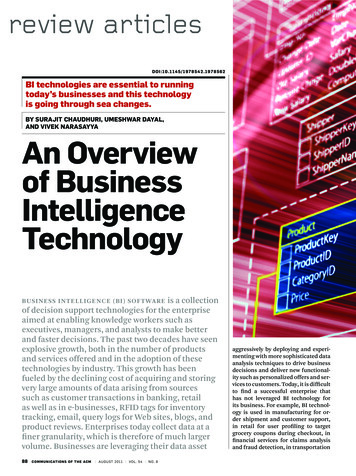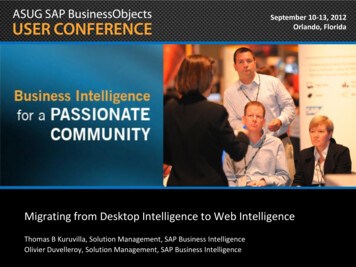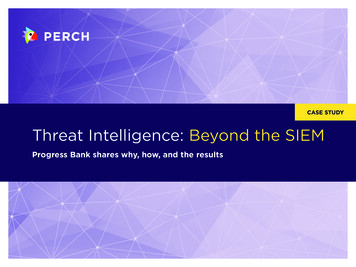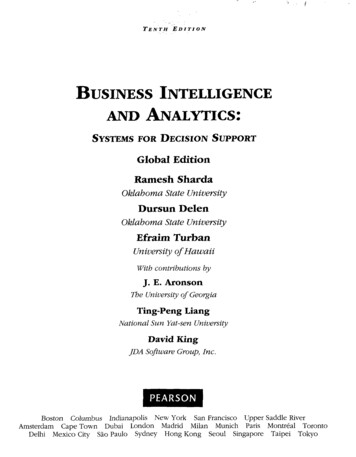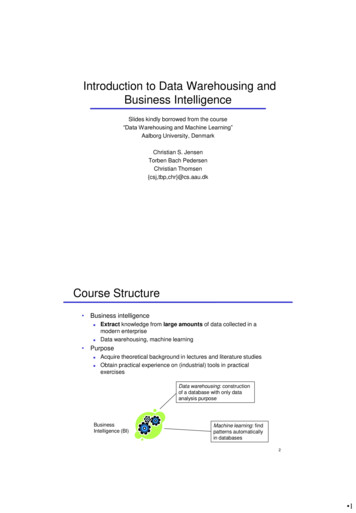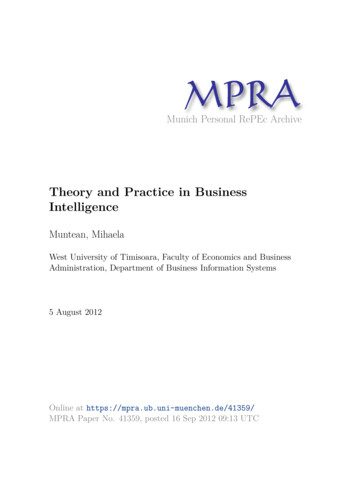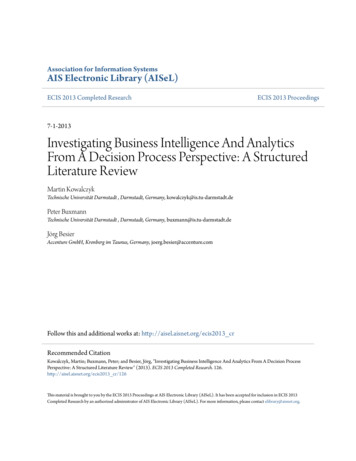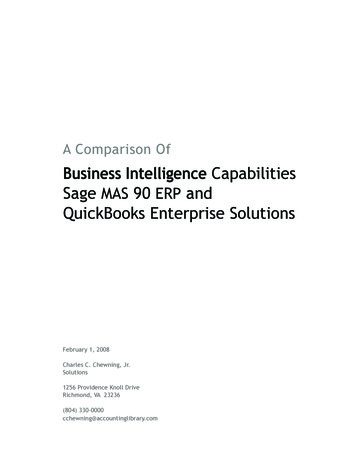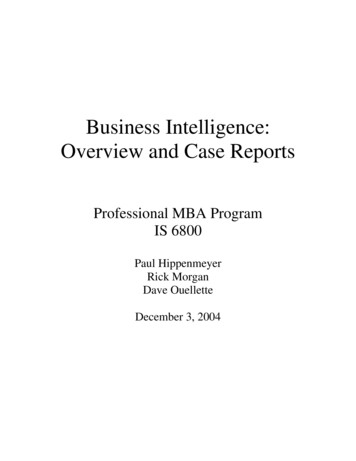
Transcription
Business Intelligence:Overview and Case ReportsProfessional MBA ProgramIS 6800Paul HippenmeyerRick MorganDave OuelletteDecember 3, 2004
Table of ContentsExecutive Summary . 1Introduction. 3Internal Business Intelligence and Espionage. 4Industrial Espionage. 5Business Espionage. 6External Business Intelligence. 8Corporate Espionage. 8Publications . 8Conferences and Trade Shows. 9Use of the Internet for gathering Business Information . 9Case Studies: BI and Ethics . 11Boeing and Lockheed: Beware of Gifts . 12Air France Knows more than you Think. 12The Sidewinder Missile Reverse Engineered. 13AFMSS: Lesson Learned. 13What to do with it all? Knowledge and Data Management . 14The Evolution of Business Intelligence . 14Is it Really Worth It? Measuring Financial Impact . 15Is it Time to Offshore?. 17BI Applications . 18Key Steps you Need to Know. 18Case Studies: Implementation of BI . 20U. S. Postal Service Gains Huge ROI. 21Applebee’s International Improves Neighborhood Image. 21MSI Systems Integrators: An Interview with Providers in Unique BI Space . 22Best Practices for Business Intelligence . 22Protection of Trade Secrets:. 22Acquisition of External Information:. 23Compilation of Internal Data: . 23Conclusions:. 23Acknowledgements. 24Bibliography and References. 25ii
Table of FiguresFigure 1.Figure 2.Figure 3.Figure 4.Figure 5.Figure 6.Figure 7.Business Intelligence Model. 3Sources of Business Intelligence. . 5Benefits of Business Intelligence. . 16Environment of Building ROI in Business Intelligence. 17The ETL Process. . 19Legacy and BI Information Flow. . 19End User Desktop Software Examples. 20iii
Executive SummaryBusiness Intelligence (BI) is a vital subject that covers a vast area of interest fortoday’s businessman. BI consists of both internal and external categories that deal withthe ability of a company to determine what its competitors are doing as well asunderstanding what forces may be at work against them. Finally, how does your businessincorporate the data that it collects into useful information yielding a competitiveadvantage? The field of BI is frequently murky and can easily cross the confusedboundaries of business ethics as well as federal law. Using current academic literature,case studies and an interview with a BI provider, we have outlined the key aspects of BIthat your business needs to understand in today’s competitive environment.What we term “Internal” Business Intelligence covers the ability of a company tokeep information from its competitors so that they may not gain a competitive advantagefrom their espionage activities. Theft can take the form of Industrial Espionage (IE), asdefined by the Economic Espionage Act of 1996 (EEA), where trade secrets are stolen bya foreign governments or agents against domestic businesses. The U.S. government hasstated that five countries are particularly involved in IE, these being France, China,Taiwan, Japan and Israel.Business Espionage, on the other hand, is defined by the Central IntelligenceAgency (CIA) as involving the theft of trade secrets by competitors, either foreign ordomestic. This may include cases where former workers for a company take theprotected trade secrets with them when they take on a new and competitive job elsewhereand use them against a previous employer.The protection of Trade Secrets has been codified by the U.S. federal governmentsince the EEA of 1996 where companies are provide limited legal protection assuming: The company identifies its trade secrets.Takes reasonable measures to protect these secrets.Educates its employees on their responsibilities to protect trade secretsEstablishes, and enforces, in-house policies to protect its trade secrets.“External” Business Intelligence involves your company’s attempts to gaininformation about a competitor to gain an advantage. Based again on a CIA definition,this is called Corporate Espionage (CE). Although the term may not seem legal, thereare many perfectly ethical methods to conduct CE.Trade publications, trade shows, conferences and the internet are all widelyaccepted legal methods of conducting CE. On the other hand there are plenty of caseswhere ethical lines were crossed and, in some cases, where the federal government hasbecome involved.
The full weight of governmental involvement may include sanctions, fines andpenalties as the Department of Justice sees fit. In extreme cases it could lead to the loss ofbillions of dollars of money as well as an incalculable loss of prestige or respect throughexposure in the media.Perhaps BI’s greatest weakness is that its Return on Investment (ROI) isfrequently hard to quantify. Very few companies are able to say exactly how much valueBI brings yet the potential losses arising from the inability to keep trade secrets can carrya devastating impact. On the flip side, making the most of your collected information, ifhandled properly, can affect the bottom line.Information technology has contributed greatly to the acquisition, processing andmelding of internal and external data. What was once a cottage industry is growingrapidly and promises sophisticated solutions that your company can use to make best useof the vast amount of data that your business acquires. The software business alone isapproximately 2 billion dollars per year. Leaders in the field include Hyperion, Cognos,the SAS Institute and Business Objects.Best Practices for BI include employee education as to both ethical and unethicalmethods used by competitors and foreign entities to mine data. Organizations that dealwith governmental secrets hold another level of responsibility to keep these areas securefrom outward attack.Externally companies should aggressively seek competitive information that isavailable in the public domain and maintain high ethical standards to help ensure thatthey stay out of trouble with the law. Last of all, technology should be used as an enablernot as an end-all. In establishing BI initiates, start small, align with a measurablebusiness outcome, enable change management and let an experienced provider help withthe extraction, transformation and loading of data into appropriate data warehouses.As stated before, BI is a vast subject that covers a lot of areas. Many parts of BIare confusing and companies can find themselves in legally and ethically gray areas veryeasily. These areas need to be understood through aggressive internal and externalBusiness Intelligence programs in order to succeed.2
IntroductionWhat is Business Intelligence (BI)? This is the main question that comes to mindwhen discussing this complex subject. According to Hannula et al, it is the Systematicbusiness information acquisition and analysis. In addition, it is also called CompetitiveIntelligence, Corporate Intelligence, Market Intelligence, Market Research, DataWarehousing, and Knowledge Management. As you can tell it is a very broad subjectwith many definitions.BI has been around for a long time. As illustrated in the class presentation, BI isnothing more than the gathering of information to give your business an advantage overyour competitors, whether it concerns rugs and carpets or the building of combat aircraft.The purpose of this paper is to explore every facet of Business Intelligence,including internal and external BI and the tangible/intangible aspects leading to acompetitive advantage. Internal BI refers to the protection and utilization of internal dataand external BI refers to the gathering of data and information about the competition.Figure 1. Business Intelligence Model.3
Internal Business Intelligence and EspionageTo paraphrase an interpretation of Sun Tzu’s “The Art of War”; it will not do fora corporation to act without knowing the competition’s strategy, and to know thecompetition’s strategy is impossible without espionage. Sun Tzu created his strategy andphilosophy over 2000 years ago and the Japanese still apply it today for business andpolitics. It is very important to understand the classifications of espionage and how abusiness can protect its physical and intellectual assets from competitors.According to CIA there are three types of Espionage when dealing with tradesecrets, businesses intelligence and competitive advantage: Industrial Espionage – Foreign government vs. Domestic Business.Business Espionage – Foreign or Domestic Business vs. Domestic Business.Corporate Espionage – Legal and ethical intelligence gathering by DomesticBusinesses, for a competitive advantage.The FBI, on the other hand defines the theft of trade secrets using the definitionsin the Economic Espionage Act of 1996 - Economic Espionage includes both: Industrial Espionage: Section 1831 - the theft of trade secrets by a foreign instrumentality¾ any agency, bureau, ministry, component, institution, association, orany legal, commercial, or business organization, corporation, firm, orentity that is substantially owned, controlled, sponsored, commanded,managed, or dominated by a foreign government; and/or a foreign agent¾ any officer, employee, proxy, servant, delegate, or representative of aforeign government.Business Espionage: Section 1832 – the theft of domestic trade secrets by a foreign or domesticbusiness.In addition, according to the Economic Espionage Act of 1996 the term tradesecret means all forms and types of financial business, scientific, technical, economic, orengineering information, including patterns, plans, compilations, program devices,formulas, designs, prototypes, methods, techniques, processes, procedures, programs, orcodes, whether tangible or intangible, and whether or how stored, compiled, ormemorialized physically, electronically, graphically, photographically, or in writing if the owner thereof has taken reasonable measures to keep such informationsecret; and4
the information derives independent economic value, actual or potential, fromnot being generally known to and not being readily ascertainable throughproper means by, the iness InfoInternal Data &Trade SecretsCorporateIntelligenceTrade ShowsIntangiblesTangiblesCompetitive AdvantageFigure 2. Sources of Business Intelligence.Industrial EspionageAs stated in the definition, Industrial Espionage is the theft of trade secrets by aforeign instrumentality and/or a foreign agent. The main countries that are activelyengaged in Industrial Espionage are: FranceChinaTaiwanJapanIsraelAn example of Industrial Espionage was the French Government, in conjunctionwith Air France, planting electronic listening devices in the seats in first class. Thepurpose of these devices was to monitor conversation between first class customersdiscussing business topics. It is unknown as to the amount of information that was lostduring these flights. Based on an ASIS survey of Fortune 1,000 companies 20% of all5
trade secret thefts are conducted by fore
Leaders in the field include Hyperion, Cognos, the SAS Institute and Business Objects. Best Practices for BI include employee education as to both ethical and unethical methods used by competitors and foreign entities to mine data. Organizations that deal with governmental secrets hold another level of responsibility to keep these areas secure from outward attack. Externally companies should .


